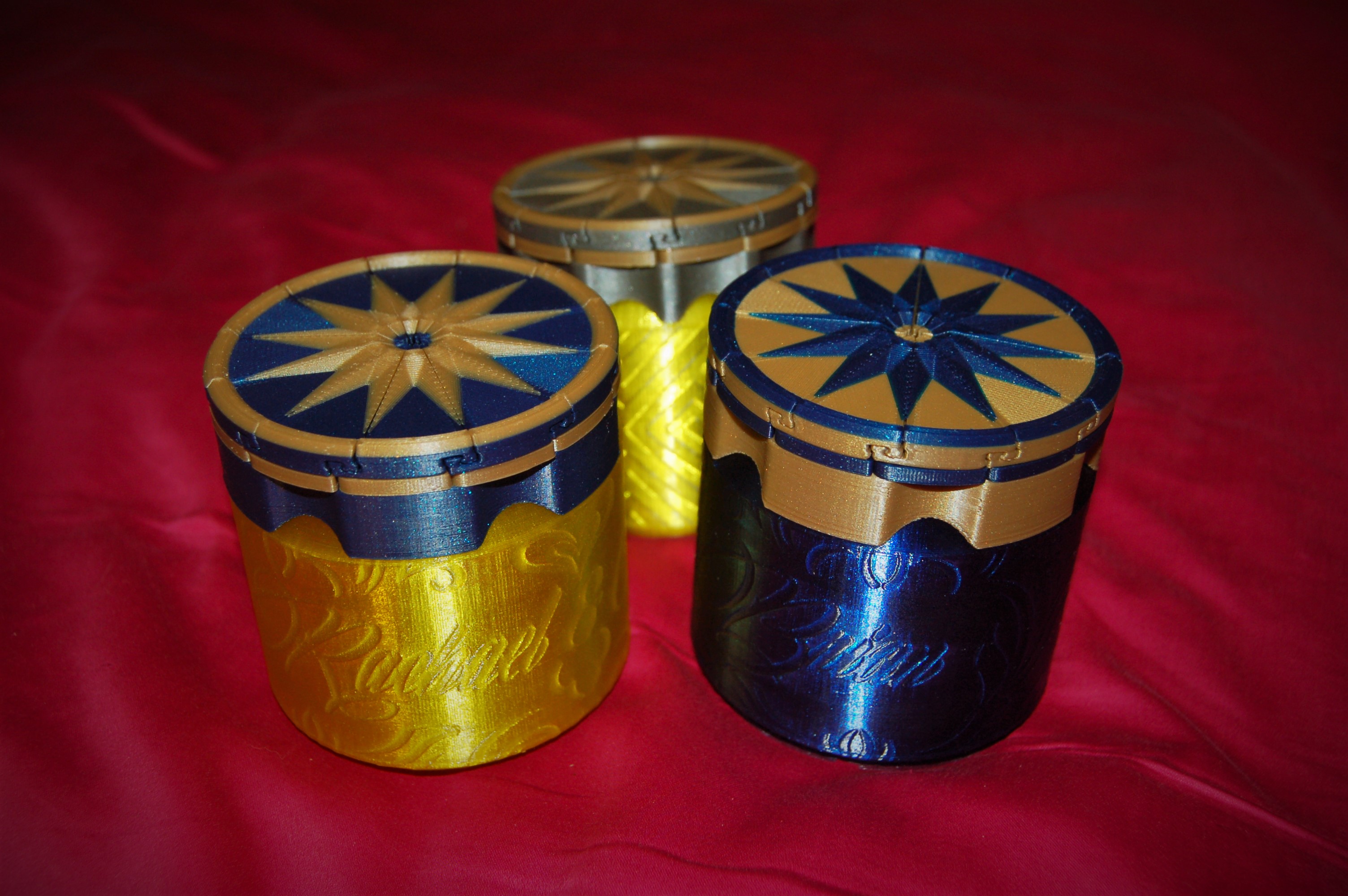
12 Leaf Aperture Iris Box
prusaprinters
<p>An improvement to the <a href="https://www.printables.com/model/314685-12-leaf-aperture-box">12 Leaf Aperture Box</a>, this box has 12 leaves, much like a camera iris, but with the structural rigidity for a functional everyday box. I have also produced the <a href="https://www.printables.com/model/315352-gear-lid-12-leaf-aperture-iris-box">Gear Lid</a> for this box.</p><p>This was originally uploaded to MyMiniFactory in 2019, and I have now moved it here as well.</p><p>I have 14 other Iris boxes designs and I have an <a href="https://www.instructables.com/Decorative-Iris-Box-Guide/">instructable</a> describing them and how to print them.</p><p>Other than the printed parts, this design requires <a href="https://www.amazon.com/s?k=M2x6+countersunk+screw&rh=n%3A17290023011&ref=nb_sb_noss">M2x6 countersunk screws</a> to assemble (as with all my other designs); 36 screws are required in total for one box. Larger or smaller screws may be used if you scale the model appropriately e.g. M3x8 screws at 150% part scale.</p><h3>Lid Designs</h3><p>There are three types of door design included: The simple 'door' is plain and flat and is used on the blue/green example; the 'star' door creates a pointed star embellishment on top of the container and 'door hyp' creates a hypnotic spiral on the box when opened.</p><p>The box is 80mm in diameter, approximately 80mm tall with the standard container and 50mm tall with the short container. There are also two different collars, 1 and 2, with six and twelve dimples respectively for twisting the opening collar.</p><h3><strong>Part testing</strong></h3><p>If you can print one of my other 'aperture' designs then you will be able to make this design.</p><p>Before printing off all the parts you should make sure the screw joints and sliding dovetail joints work correctly with your print settings. Use settings which give good accuracy e.g. 0.1mm layer height. I recommend at least 3 perimeters with an 0.4mm nozzle.</p><p>Print two of the 'Door' parts and test the dovetail sliding. Be careful when adding supports to the dovetails, to only support the outer part (as shown in the pictures). The inner part can be bridged easily, and adding unecessary supports here will likely make it hard to remove them from the parts and add friction to the dovetails.</p><figure class="image image_resized" style="width:88.18%;"><img src="https://media.printables.com/media/prints/315318/rich_content/e7aa3adb-03af-4b43-ba98-d440e4c3f3b7/dovetail-support-setup.png#%7B%22uuid%22%3A%22e52465ae-bdb8-4edf-a7e2-da79b014737d%22%2C%22w%22%3A857%2C%22h%22%3A586%7D"></figure><figure class="image image_resized" style="width:87.36%;"><img src="https://media.printables.com/media/prints/315318/rich_content/8ea4b56a-2e6a-401b-9fb0-e6a0de60693c/dovetail-support-slicing.png#%7B%22uuid%22%3A%223b029488-5bd2-4339-b276-f57a919f754b%22%2C%22w%22%3A857%2C%22h%22%3A586%7D"></figure><figure class="image image_resized" style="width:86.55%;"><img src="https://media.printables.com/media/prints/315318/rich_content/3be29516-18c5-4654-b46f-c964f6a04df7/dsc_0493.jpg#%7B%22uuid%22%3A%2242b0c3c6-a44b-4a94-8836-f08538e86f5d%22%2C%22w%22%3A3008%2C%22h%22%3A2000%7D"></figure><figure class="image image_resized" style="width:85.46%;"><img src="https://media.printables.com/media/prints/315318/rich_content/172a9de0-6606-45b6-935f-22373dec1499/dsc_0496.jpg#%7B%22uuid%22%3A%222d61b687-03d2-4887-915a-97b6a884e620%22%2C%22w%22%3A3008%2C%22h%22%3A2000%7D"></figure><figure class="image image_resized" style="width:84.65%;"><img src="https://media.printables.com/media/prints/315318/rich_content/86e8c562-3e79-44ed-b7e3-74c54c461e13/dsc_0497.jpg#%7B%22uuid%22%3A%2236d6a435-ca7a-4b52-ace5-e68880b776c2%22%2C%22w%22%3A3008%2C%22h%22%3A2000%7D"></figure><figure class="image image_resized" style="width:83.83%;"><img src="https://media.printables.com/media/prints/315318/rich_content/827b6658-6423-48e5-8484-10c3a493c780/dsc_0500.jpg#%7B%22uuid%22%3A%227a6165eb-2d7f-4bd8-9d66-4d2d740d586b%22%2C%22w%22%3A3008%2C%22h%22%3A2000%7D"></figure><p>They should be loose enough to slide easily for the design to work effectively. Try to avoid 'elephants foot' on the base of the doors, as this can reduce tolerances and cause excess friction. If they are too tight then try reducing the layer height or using contour XY compensation in your slicer. Lower friction materials are also important; PLA works great.</p><p>Check that the screws fit tightly in the holes on the base of the doors. Also check they turn freely in the links and that the head is flush with the part surface. You may need to scale the parts or use XY compensation to get a good fit.</p><h3>Parts Printing</h3><figure class="image image_resized" style="width:84.65%;"><img src="https://media.printables.com/media/prints/315318/rich_content/78232e88-f176-48fe-b6df-0300206a7ad3/dsc_0492.jpg#%7B%22uuid%22%3A%22dff2e432-1001-4eb7-9438-0c802507a48a%22%2C%22w%22%3A3008%2C%22h%22%3A2000%7D"></figure><p>To make the box you will need to print: </p><ul><li>1x 'Container' or ‘Short Container’ </li><li>1x 'Collar 1' or ‘Collar 2’ </li><li>12x ‘Link 1’ </li><li>6x ‘Link 2’ </li><li>12x 'Door' of any type.</li></ul><p>For multicoloured lids, do a material swap at the appropriate height.</p><p>The pattern on some of the containers was formed using the velocity painting technique (more info in my <a href="https://www.instructables.com/Decorative-Iris-Box-Guide/">Instructable</a>). The line pattern on the yellow container was Designed by <a href="https://www.freepik.com/freepik">Freepik</a>. The triangular pattern was remixed from a design by <a href="https://www.freepik.com/freepik">rawpixel.com / Freepik</a>. The floral pattern was remixed from a design by <a href="https://www.freepik.com/freepik">GarryKillian / Freepik</a>.</p><h3>Assembly</h3><h4>Step 1</h4><figure class="image image_resized" style="width:88.85%;"><img src="https://media.printables.com/media/prints/315318/rich_content/e210d5bf-3b28-4970-acf5-35b5b8c1f4c0/dsc_0488.jpg#%7B%22uuid%22%3A%22b6278a0b-797c-4557-ad5f-3c3dff03540e%22%2C%22w%22%3A3008%2C%22h%22%3A2000%7D"></figure><p>Take the container and place the collar onto it.</p><h4>Step 2</h4><figure class="image image_resized" style="width:88.3%;"><img src="https://media.printables.com/media/prints/315318/rich_content/1a535aa5-1a10-4fbb-9c97-c63139f4c13e/dsc_0485.jpg#%7B%22uuid%22%3A%22d410cbe8-49b7-42e4-8ecc-a7d84fe875a4%22%2C%22w%22%3A3008%2C%22h%22%3A2000%7D"></figure><p>Screw the narrower ends of the six larger links (Link 2) to the holes in the container. The collar should now be held securely onto the box but also be able to twist freely.</p><h4>Step 3</h4><figure class="image image_resized" style="width:84.61%;"><img src="https://media.printables.com/media/prints/315318/rich_content/30a8980c-742c-4392-bb49-5e5eadd470b4/dsc_0482.jpg#%7B%22uuid%22%3A%222d316951-eb8b-4539-9ccc-8a897e130c70%22%2C%22w%22%3A3008%2C%22h%22%3A2000%7D"></figure><p>Screw the non-pointed ends of the smaller links (Link 1) to the collar.</p><figure class="image image_resized" style="width:83.89%;"><img src="https://media.printables.com/media/prints/315318/rich_content/4add253f-307c-4285-b371-2cf44e169aa2/dsc_0477.jpg#%7B%22uuid%22%3A%227d46d4a8-eea1-405b-ab87-55937c072020%22%2C%22w%22%3A3008%2C%22h%22%3A2000%7D"></figure><h4>Step 4</h4><figure class="image image_resized" style="width:83.29%;"><img src="https://media.printables.com/media/prints/315318/rich_content/e558086c-54d4-4295-ac8e-0ed655896ed4/dsc_0476.jpg#%7B%22uuid%22%3A%22865ab3cc-4119-4721-a607-ad2c424ab9d8%22%2C%22w%22%3A3008%2C%22h%22%3A2000%7D"></figure><p>For attaching the links to the doors it's easiest if you roughly assemble the doors in the open position upside down and place the container and collar assembly on top of them. Now screw the other end of the larger links to the inside holes on the doors.</p><figure class="image image_resized" style="width:82.47%;"><img src="https://media.printables.com/media/prints/315318/rich_content/489335bb-2c2e-4cef-9f89-45f7d623c75a/dsc_0471.jpg#%7B%22uuid%22%3A%223a1dc2c7-7c11-4546-965a-880652cc649f%22%2C%22w%22%3A3008%2C%22h%22%3A2000%7D"></figure><h4>Step 5</h4><figure class="image image_resized" style="width:81.66%;"><img src="https://media.printables.com/media/prints/315318/rich_content/2fc936db-4eec-4979-9e19-072c01cef48d/dsc_0466.jpg#%7B%22uuid%22%3A%22d249ffd8-1258-4ba2-ac08-0ddee7b342a4%22%2C%22w%22%3A3008%2C%22h%22%3A2000%7D"></figure><p>Now screw the smaller links to the holes on the outside edge of the box doors.</p><p>You should now have a working Aperture Iris box! The mechanism may be a little stiff at first but should loosen up over time. A little bit of silicon lubricant can also be used on the dovetail joints to make it work more smoothly.</p><figure class="image image_resized" style="width:81.4%;"><img src="https://media.printables.com/media/prints/315318/rich_content/22c120f8-d77b-416f-ae61-9c066b04405a/dsc_0447.jpg#%7B%22uuid%22%3A%226f560b78-0428-44bf-b636-57611d12cec2%22%2C%22w%22%3A3008%2C%22h%22%3A2000%7D"></figure><p>If you have any questions or problems with this design, I will be more than happy to help.</p>
With this file you will be able to print 12 Leaf Aperture Iris Box with your 3D printer. Click on the button and save the file on your computer to work, edit or customize your design. You can also find more 3D designs for printers on 12 Leaf Aperture Iris Box.
